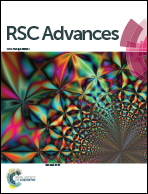A self-assembled net structured film for the immobilization of tris(2,2′-bipyridyl)ruthenium(ii) and its ultrasensitive electrogenerated chemiluminescent sensing for phenol†
Abstract
A self-assembled net structure to immobilize tris(2,2′-bipyridyl)ruthenium(II) ditetrakis(4-chlorophenyl)borate (RuDB) onto a gold surface is presented here for the first time. The formation of the net structure involved alternately depositing 1,10-decanedithiol (DDT) and gold nanoparticles (AuNPs) on the gold surface. The RuDB molecules became distributed in the spaces between the long chains of DDT and were successfully immobilized in the formed net structure. Repeating the modification process fabricated a much larger net structure incorporating more RuDB. The fabrication process is very simple, effective and low cost. An electrogenerated chemiluminescence (ECL) study confirmed that RuDB immobilized in the net structure was considerably stable and exhibited excellent ECL behavior. Moreover, the ECL signal of the proposed sensor was sensitively inhibited by phenol and exhibited a low detection limit of 0.6 nM with a signal-to-noise ratio of 3. Consequently, the design of the net structure for immobilizing probe molecules may be promising for other sensing applications.


 Please wait while we load your content...
Please wait while we load your content...